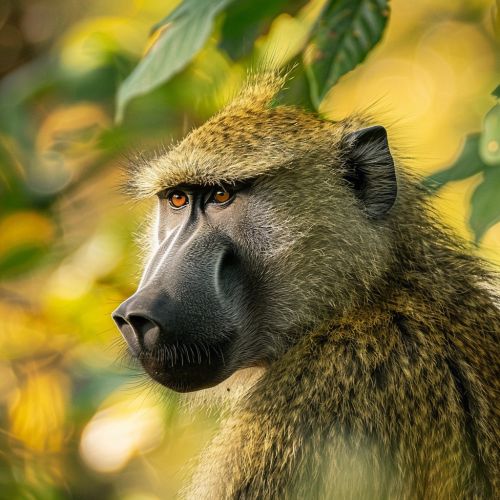Yellow baboon
Taxonomy and Evolution
The yellow baboon (Papio cynocephalus) is a member of the primate family Cercopithecidae, more commonly known as the Old World monkeys. The genus Papio, to which the yellow baboon belongs, is comprised of six distinct species, all of which are native to Africa or the Arabian Peninsula.


The yellow baboon and its relatives are believed to have diverged from their common ancestor around 1.8 million years ago, during the early Pleistocene epoch. This divergence was likely driven by environmental changes, leading to the evolution of distinct species adapted to different ecological niches.
Physical Characteristics
Yellow baboons are medium-sized primates, with males typically larger than females. Males can weigh between 20 and 30 kilograms, while females usually weigh between 12 and 16 kilograms. They have a body length of 60 to 84 centimeters, not including the tail, which can add an additional 40 to 60 centimeters.
The yellow baboon's coat is, as its name suggests, yellowish-brown, although the exact shade can vary. The face is hairless and black, with prominent cheek pouches for storing food. The yellow baboon's long, pointed muzzle is one of its most distinctive features, setting it apart from the more rounded faces of the great apes.
Behavior and Ecology
Yellow baboons are diurnal, meaning they are active during the day and sleep at night. They are primarily terrestrial, spending most of their time on the ground, although they can climb trees to find food or escape from predators.
Yellow baboons live in complex, hierarchical societies known as troops. These troops can range in size from a few dozen individuals to over a hundred. Within these troops, both males and females have their own dominance hierarchies, which are established and maintained through a combination of aggression, grooming, and alliance formation.
Yellow baboons are omnivorous, with a diet that includes fruits, grasses, seeds, and invertebrates. They have also been known to eat small vertebrates, including birds and rodents.
Reproduction and Life Cycle
Female yellow baboons reach sexual maturity at around six years of age, while males mature slightly later, at around eight years. Females give birth to a single offspring after a gestation period of approximately six months. The young baboon is cared for primarily by its mother and other females in the troop.
Yellow baboons have a lifespan of up to 30 years in the wild, although many do not reach this age due to predation and disease. In captivity, they can live for up to 45 years.
Conservation Status
The yellow baboon is currently listed as Least Concern by the International Union for Conservation of Nature (IUCN). However, like many wildlife species, they face threats from habitat loss and hunting.
